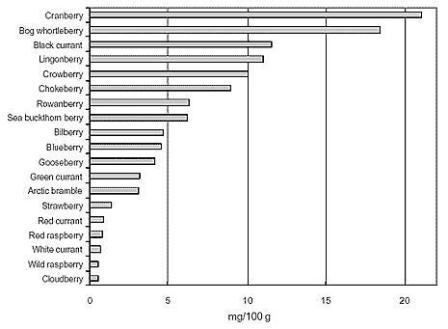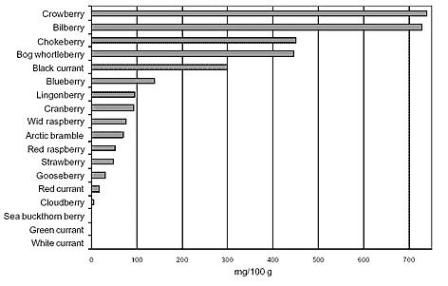Bountiful Berries
Berries are small fleshy fruits, made up 80-90% water, low levels of sodium, and large amounts of potassium, which all together help the body maintain weight control and low blood pressure. They are high in insoluble fiber (cellulose), which is important for intestinal health and the prevention of constipation. They are also high in soluble fiber (pectin), which lowers blood cholesterol and sugar levels.
The fact that these fruits have a low sugar content and are absent of cholesterol, make them beneficial for diabetics as well as for the prevention of cardiovascular disease (1),(2). It has been known for many years that the consumption of fruits provides the body with antioxidants it needs to ward of disease, but comparison of various fruits shows that antioxidants like vitamin C and E are highest among berry fruits.
For example, the guavaberry is high in vitamin C. The camu camu berry is even higher with 30-60 times more vitamin C than an orange, while the health benefits of fruits like the goji berries , and the Chinese Bayberry , used for centuries in Chinese medicine, are becoming increasingly understood. Antioxidants protect the body against harmful free radicals, which may cause aging and many chronic diseases.
In addition to containing high amounts of antioxidants, several thousand phenolic compounds like flavonoids, phenolic acids, tannins, and lignans, as well as several subgroups are found in them. These compounds have many positive effects on overall health, but recent studies focus on the benefits of consuming a flavonoid called anthocyanin.
The health benefits of anthocyanin include: antimicrobial, anti-inflammatory, anti-allergic, anti-thrombotic, and anti-carcinogenic effects (3),(4),(5),(6). High intake of flavonoids like flavonol and anthocyanin can also prevent coronary heart disease, stroke, lung cancer, prostate cancer, asthma, type 2 diabetes, and lower the risk of Alzheimer’s disease (7),(8).
The highest content of flavonols can be found in cranberries, bog whortleberries, black currants, lingonberries, crowberries and chokeberries. The highest content of anthocyanin can be found in red and blue/black varieties such as acai , crowberries,
bilberry , chokeberries, blackberries and blueberries (9). Even ripe gooseberries have high levels.
Content of flavanols

Content of anthocyanins

As illustrated in both charts, almost all of them contain high levels of antioxidants. Those like cranberries , strawberries , red raspberries , and cloudberries have antimicrobial properties that prevent the growth of E. coli and salmonella, while having no effect on the beneficial probiotic lactic acid bacteria that are normally found in the intestine (4). In addition, the consumption of berries has been shown to help prevent urinary tract infections (3).
References
1. Edman JW, Balentine D, Arab L, Beecher G, Dwyer JT, Folts J, Harly J, Hollman P, Keen CL, Mazza G, Messina M, Scalbert A, Vita J, Williamson G, Burrowes J. (2007) Flavonois and Heart Health: Proceedings of the ILSI North America Flavonoids Workshop. Journal of Nutrition, 137 (3):718S-37S.
2. Tsuda T, Ueno Y, Yoshikawa T, Kojo H, Osawa T. (2006) Microarray profiling of gene expression in human adipocytes in response to anthocyanins. Biochemical Pharmacology, 71 (8):1184-97.
3. Jepson RG, Craig JC. (2007) A systematic review of the evidence for cranberries and blueberries in UTI prevention. Molecular Nutrition and Food Resource, 51 (6):738-45.
4. Nohynek LJ, Alakomi HL, Kahkonen MP, Heinonen M, Helander IM, Oksman-Caldentey KM, Puupponen-Pimia RH. Berry phenolics: antimicrobial properties and mechanisms of action against severe human pathogens. Nutrition and Cancer, 54 (1):18-32.
5. Lau FC, Bielinski DF, Joseph JA. (2007) Inhibitory effects of blueberry extract on the production of inflammatory mediators in lipopolysaccharide-activated BV2 microglia. Journal of Neuroscientific Research, 85 (5):1010-7.
6. Wada L, Ou B. (2002) Antioxidant activity and phenolic content of Oregon caneberries. Journal of Agricultural Food Chemistry, 50 (12):3495-500.
7. Knekt P, Kumpulainen J, Jaervinen R, Rissanen H, Helioevaara M, Reunanen A, Hakulinen T, Aromaa A. (2002) Flavonoid intake and risk of chronic disease. American Journal of Clinical Nutrition, 76 (3):560-8.
8. Dai Q, Borenstein AR, Wu Y, Jackson JC, Larson EB. Fruit and vegetable juices and Alzheimer’s disease: The Kame Project. American Journal of medicine, 119 (9):751-9.
9. Harri, K. (2003) Health benefits of berries: Possibility of Northern berries, Finnish-Canadian view. University of Kuopio, Finland Retrieved January 20, 2008 from http://www.uku.fi/northernberries/health.shtml



